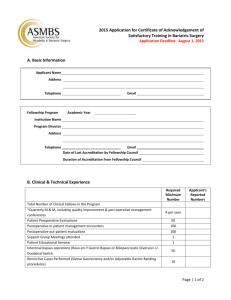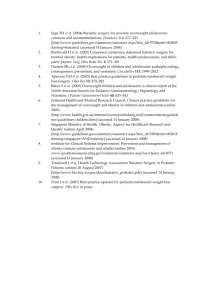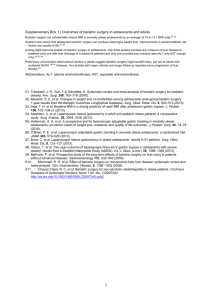Bariatric Care: Acute OT Role - Slides
advertisement
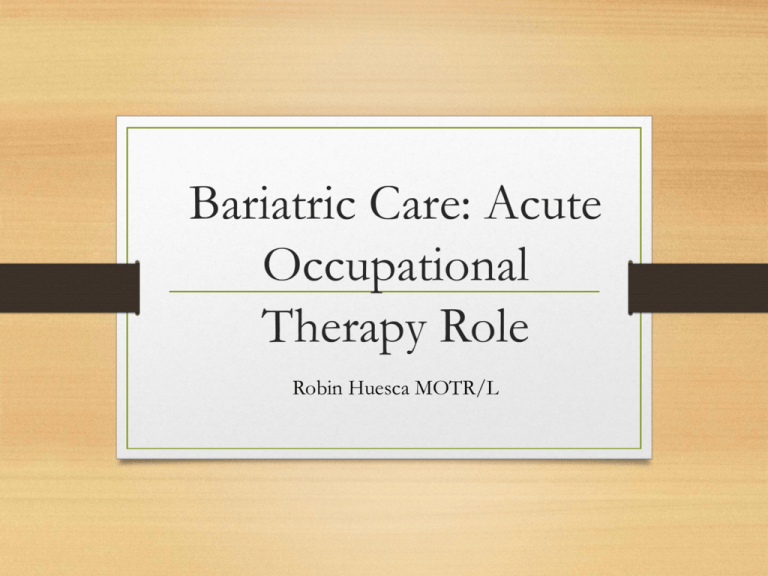
Bariatric Care: Acute Occupational Therapy Role Robin Huesca MOTR/L Bariatric Care • Issue: the care of bariatric clients often is riddled with decreased familiarity in bariatric care: ranging from sub-optimal equipment and environmental barriers, personal bias and significant caregiver burden. • Goal: to broaden understanding of realistic evidencebased solutions for therapist to improve client independence and decreased burden of daily care to interdisciplinary team members Session Objectives 1) Understand barriers and identify solutions to achieve independent self-care performance of the bariatric client in the acute setting 2) Understand barriers and identify solutions to achieve an optimal disposition for bariatric clients in the acute setting. 3) Familiarize and expand knowledge of bariatric equipment for both acute and home setting Body Mass Index (BMI) Categorizing Bariatric Weight Distribution 1. 2. 3. 4. Anasarea Apple Pear Bulbous Apple Ascites Distribution Apple Pannus Distribution Bulbous Gluteal Region Proportionate Stigma • A stigmatized trait can lead to experiences of discrimination and the feeling of being stigmatized can put one at risk for low self esteem, depression and lower quality if life. • Weight bias and stigma is often referred to as the “last socially acceptable form of racism” • The negative attitudes underlying the enacted stigma can be explicit or implicit (conscious or automatic) Healthcare provider/patient relationships Patient Obesity Provider Stereotype of patient Provider attitudes(enacted stigma) Threatening environmental cues Provider biased decision making Patient avoidance of care Patient Stress Patient mistrust of Provider Patient Poor Compliance Poor communication in pt/provider interaction Poor Outcomes Perceived Attitudes in the Care of the Obese patients • Nursing study: 70 percent of nurses reported they felt that morbidly obese patients are more demanding in interpersonal relationships than on obese patients • They reported high levels of dependency in ADL’s (8 areas), the highest need in bathing, dressing toileting and self care (greater than 80% patients required assist) Factors contributing to perceptions • Baseline barriers in household structures (bathrooms unable to accommodate obese patient and/or equipment) • Baseline inability to get in/out of bed (both home and in hospital) • High degree of assist required for hygiene care (clothing, skin challenges, lifting skin folds) • Safety issues- falls, CG injuries, proper equipment • Psychosocial issues related to resulting from obesity The Reality of Care Needs (Porkorny, 2009) Activity % of Assistance Required Bathing 90 Dressing 87 Toileting 84 Skin Care 82 Feeding/food (shopping or prep) 66 Getting out of Bed 54 Feeding/food (eating) 25 Oral Hygiene 11 Physiological consequences of weight gain • Increases the demands for insulin pancreatic failureDM • Hyperinsulinemia sodium retention hypertension • Increased triiodothyronine (T3 T4) metabolic rate increased cardia output heart failure • Increased need for oxygenation and alveolar ventilation to maintain adequate tissue perfusion placing them high risk of Pickwickian syndrome and sleep apnea (especially when their weight is primarily adnominal girth-resting on chest Mobilizing – why is this so complex? • Human loads are heavy, highly dependent and unpredictable • Self mobilization of the bariatric patient is often complex as the medical treatment the patient is receiving is often a health related consequence resulting from their weight Systematic steps for safe mobilization of the bariatric patient 1. Bariatric risk assessment 2. Moving and handling assessment 3. Equipment provision Pitfalls of “Weight” and “Equipment Capacities” • Appropriate equipment should be picked based on the needs of the specific patient, not just weight and capacity. Should consider: • Physical limitations of patients (limited ROM, panus) • Physical characteristics i.e. weight distribution, girth, width • Cognition • Psychosocial Status The Bariatric Triad 1. Expandable support surface bariatric bed 2. Weight-rated portable bedside lifts 3. Weight-rated wheel chair What if? Ideal Bariatric Suite • 5 feet service area around the bed • Double entry door • Eliminate bathroom replace with foldaway/rectactible wall separating the bathroom area from a regular room Why Does This Equipment “fit” The patient? Positioning in Chair • Some bariatric clients cannot keep their legs together enough to even get them on the footplates on a w/c or within the frame of the walker wider walker, uneven depth seating, expanded foot plates • May not be strong enough if the client needs to push themselves back to reposition- longer arm rests • Maceration problems and skin breakdown because of moisture; excess tissue creates shearing and friction issues. Gap for posterior flow Clinical Solutions Issue? Work around The Issues Across the Span of Many Settings • • • • Ambulance- stretcher and transport capacity ER gurney, transport w/c, scale OR/Imagining operating table, CT, MRI Room bed, lift system, slings, w/c, walkers, chair, stretchers, commode, bed pan, shower chair, sit stand device, mattress, gowns, BP cuffs, needles, socks, scale • Home or facility transfer bed, w/c, shower chair, BSC, lift, scale, entry access, door frame and footprint • School desks, resource rooms, bathroom accessibility “Equipment alone is not the answer for improving quality of care unless supported by sound clinical judgment, robust policies and procedures which in turn bring about systems of work that is both safe for the patient and the carers” Cookson 2002 References • Watanabe, L; The Anatomy of Bariatric Mobility Understanding the Unique Clinical, Accessibility & Funding Challenges; Mobility Management; 2010; electronically obtained 10/2015 • Darrah, A. Campo, M, Frost, L. Safe-Patient Handling Equipment in Therapy Practice: Implications for Rehabilitation. AJOT (2013) Vol 67 (1) Electronically obtained 9/2015 • Faintuch, J. Souza, A. Rehabilitation Needs after bariatric surgery. European Journal of Physical and rehabilitation Medicine (2013) Vol 49 (3) Electronically obtained 9/2015 • Budd, G. Mariotti, M. Health care professionals attidudes about obesity: An integrative Review. Applied Nursing Research 24 (2011) p. 127-137. Electronically obtained 8/2015 • Bell, S. Current Issues and Challenges in the Management of Bariatric Patients. J WOCN Vol 32 (6) . Electronically obtained 8/2015 • Hammond, K. Practice Issues in the Surgical Care of the Obese Patient. The Oschner Journal 13; 224-227, 2013, Electronically obtained 8/2015 • Olowski, B. Stolfi, A, Safe Patient Handling Perceptions and Practice: A survey of Acute Care Physical Therapists, PT 2014; 94: 682-695, electronical obtained 9/2015 References • Barr, J. Cunnenn, J. Understanding the Bariatric Client and Providing a Safe Hospital Environment. Clinical Nurse Specialist, 2001. Vol 15 (5) 215-223; electronically obtained 8/2015 • Saffari, M. Special Care for Special Needs. Journal of Rehabilitation, 2007, electronically obtained 8/2015 • Muir, M. Archer-Hesse, G. Essentials of Bariatric Patient Handling Program. The online Journal of Issues in Nursing. 2009. Electronic obtained 9/2015 • Phelan, S.M. Burgess, D, J. The impact of weight bias and stigma on the quality of care and outcomes for patients with obesity. Obesity Reviews, 2015; Vol 16; electronically obtained 9/2015 • Porkorny, M. Scott, E. Challenges in Caring for Morbidly Obese Patients- Managing Activities for Daily Living. Home Helath Care Nurse. Vol 27 (1) 2009. Electronically obtained 8/2015 • Rush, A. Use of specialized equipment to mobilize bariatric equipment. International Journal of Therapy and Rehabilitation, 2005. Vol 12 (6). Electronically obtained 8/2015 • Liko (2004) Body Weight Distribution. Liko www.liko.com
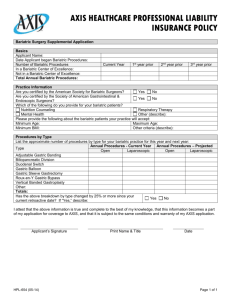
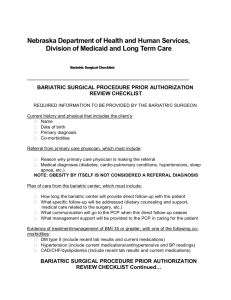
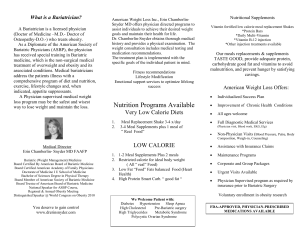
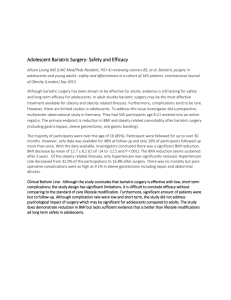
![Joel_Bradley_[NCSC_ACS]_Bradley_](http://s3.studylib.net/store/data/007144708_1-61c5732b3c6b9504141b9285237b4b69-300x300.png)
